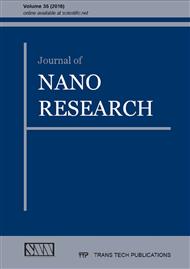[1]
World Health Organization, Global Tuberculosis Report 2014, Geneva (2014). Information on http: /www. who. int/tb/publications.
Google Scholar
[2]
World Health Organization, Global Tuberculosis Report 2014, Geneva (2013). Information on http: /www. who. int/tb/publications.
Google Scholar
[3]
F. Abebe, C. Holm-Hansen, H.G. Wiker, G. Bjune, Progress in serodiagnosis of Mycobacterium tuberculosis infection, Scandinavian Journal of Immunology. 66 (2007) 176-191.
DOI: 10.1111/j.1365-3083.2007.01978.x
Google Scholar
[4]
M.D. Perkins, J. Cunningham, Facing the Crisis: Improving the Diagnosis of Tuberculosis in the HIV Era, The Journal of Infectious Diseases. 196 (2007) S15–27.
DOI: 10.1086/518656
Google Scholar
[5]
S.A. Martins, V.C. Martins, F.A. Cardoso, P.P. Freitas, L.P. Fonseca, Waterborne Pathogen Detection Using a Magnetoresistive Immuno-Chip, in: Springer Protocols Handbooks, Molecular Biological Technologies for Ocean Sensing, 2012, pp.263-288.
DOI: 10.1007/978-1-61779-915-0_13
Google Scholar
[6]
S.A. Martins, V.C. Martins, M.T.B. Frasco, A.G.B. Castro, P.P. Freitas, L.P. Fonseca, Magnetic labeling of waterborne pathogens towards a magnetoresistive-based biochip, Conference Proceeding of Ibersensor. 9-11 November, 2010, Lisbon, Portugal.
Google Scholar
[7]
J. Germano, V.C. Martins, F.A. Cardoso, T.M. Almeida, L. Sousa, P.P. Freitas, M.S. Piedade, A portable and autonomous magnetic detection platform for biosensing, Sensors (Basel). 9(6) (2009) 4119-37.
DOI: 10.3390/s90604119
Google Scholar
[8]
E. Fernandes E, V.C. Martins, C. Nóbrega, C.M. Carvalho, F.A. Cardoso, S. Cardoso, J. Dias, D. Deng, L.D. Kluskens, P.P. Freitas, J. Azeredo, A bacteriophage detection tool for viability assessment of Salmonella cells, Biosensors and Bioelectronics. 52 (2014).
DOI: 10.1016/j.bios.2013.08.053
Google Scholar
[9]
A. Cruz, A.G. Fraga, J.J. Fountain, J. Rangel-Moreno, E. Torrado, M. Saraiva, D.R. Pereira, T.D. Randall, J. Pedrosa, A.M. Cooper, A.G. Castro, Pathological role of interleukin 17 in mice subjected to repeated BCG vaccination after infection with Mycobacterium tuberculosis, The Journal of Experimental Medicine. ; 207(8) (2010).
DOI: 10.1084/jem.20100265
Google Scholar
[10]
P. Bettencourt, D. Pires, N. Carmo, E. Anes, Application of confocal microscopy for quantification of intracellular mycobacteria macrophages, in: A. Méndez-Vilas, J. Díaz (Eds. ), Microscopy: Science, Technology, Applications and Education, Badajoz: Formatex Research Center, 2010, 1, pp.614-621.
Google Scholar
[11]
M.M. Bradford, A rapid and sensitive method for the quantitation of microgram quantities of protein utilizing the principle of protein-dye binding, Analytical Biochemistry. 72 (1976) 248-54.
DOI: 10.1016/0003-2697(76)90527-3
Google Scholar
[12]
R. Treuer, S.E. Haydel, Acid-fast staining and Petroff-Hausser chamber counting of mycobacterial cells in liquid suspension, in: Current Protocols in Microbiology, 2011, Chapter 10, Unit 10A. 6.
DOI: 10.1002/9780471729259.mc10a06s20
Google Scholar
[13]
V.C. Martins, F.A. Cardoso, J. Germano, S. Cardoso, L. Sousa, M. Piedade, P.P. Freitas, L.P. Fonseca, Femtomolar limit of detection with a magnetoresistive biochip, Biosensors and Bioelectronics. 24 (8) (2009) 2690–2695.
DOI: 10.1016/j.bios.2009.01.040
Google Scholar
[14]
V.C. Martins, J. Germano, F.A. Cardoso, J. Loureiro, S. Cardoso, L. Sousa, M. Piedade, L.P. Fonseca, P.P. Freitas, Challenges and trends in the development of a magnetoresistive biochip portable platform, Journal of Magnetism and Magnetic Materials. 322 (9–12) (2010).
DOI: 10.1016/j.jmmm.2009.02.141
Google Scholar
[15]
H. Zhang, P.S. Williams, M. Zborowski, J.J. Chalmers, Binding affinities/avidities of antibody-antigen interactions: quantification and scale-up implications, Biotechnology and Bioengineering. 95(5) (2006) 812-29.
DOI: 10.1002/bit.21024
Google Scholar
[16]
B. Byrne, E. Stack, N. Gilmartin, R. O'Kennedy, Antibody-Based Sensors: Principles, Problems and Potential for Detection of Pathogens and Associated Toxins, Sensors. 9 (2009) 4407-4445.
DOI: 10.3390/s90604407
Google Scholar
[17]
V.C. Martins, F.A. Cardoso, P.P. Freitas, L.P. Fonseca, Picomolar detection limit on a magnetoresistive biochip after optimization of a thiol-gold based surface chemistry, Journal of Nanoscience and Nanotechnology. 10 (9) (2010) 5994-6002.
DOI: 10.1166/jnn.2010.2595
Google Scholar
[18]
B. Masereel, M. Dinguizli, C. Bouzin, N. Moniotte, O. Feron, B. Galle, T.V. Borght, C. Michiels, S. Lucas, Antibody immobilization on gold nanoparticles coated layer-by-layer with polyelectrolytes, Journal of Nanoparticle Research. 13(4) (2011).
DOI: 10.1007/s11051-010-9908-3
Google Scholar
[18]
Top of Form F.A. Cardoso, J. Germano, R. Ferreira, S. Cardoso, V.C. Martins, P.P. Freitas, M.S. Piedade, L. Sousa, Detection of 130 nm magnetic particles by a portable electronic platform using spin valve and magnetic tunnel junction sensors, Journal of Applied Physics. 103 (2008).
DOI: 10.1063/1.2836713
Google Scholar


